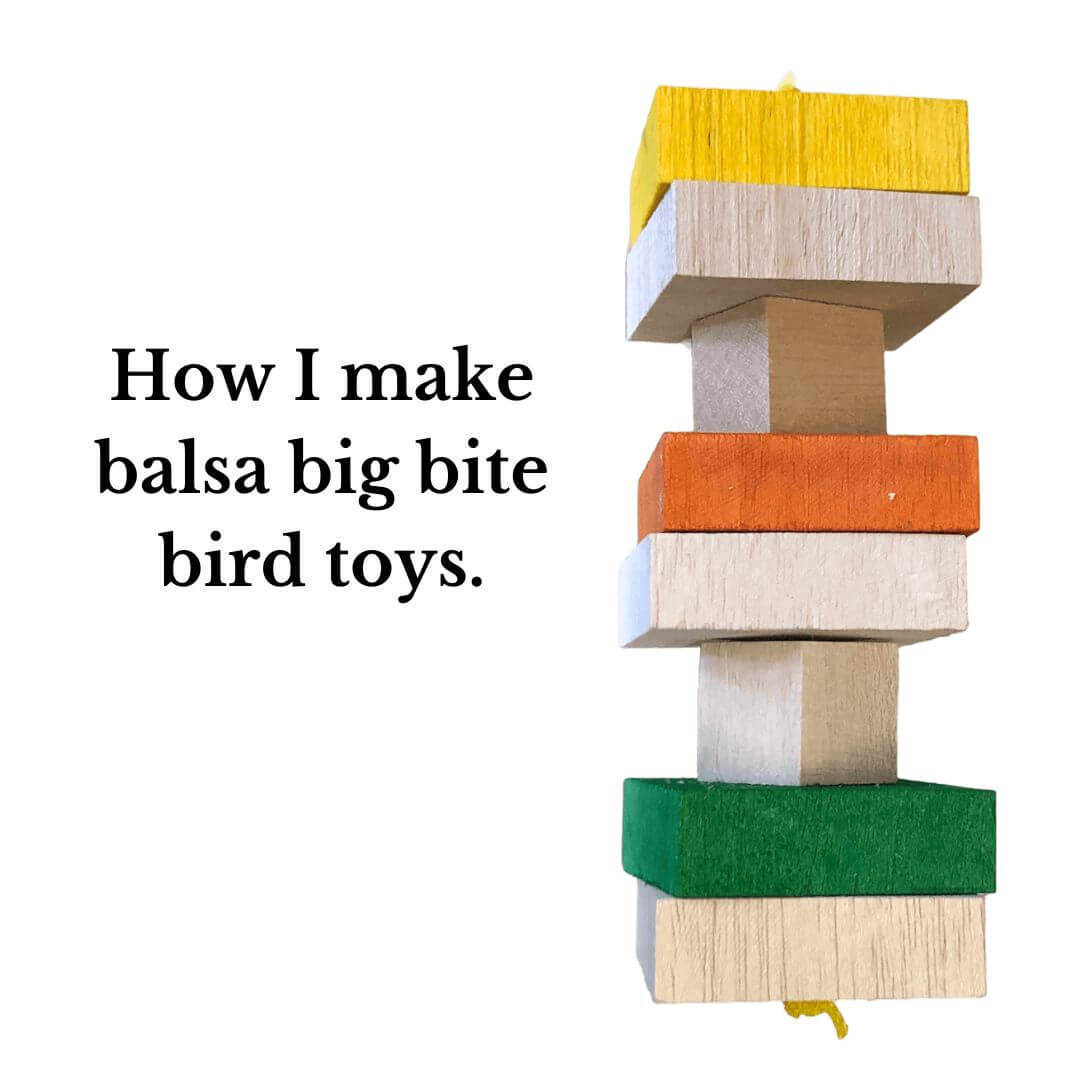
How I Make Balsa Big Bite Bird Toys
Handmade balsa toys offer excellent enrichment opportunities for your bird. As they explore and interact with the toys, they engage in natural behaviors such as chewing, shredding, and problem-solving. This mental and physical stimulation is essential for your bird's overall well-being and helps prevent boredom and behavioral issues. Shop Now: Balsa Bird Toys

By handcrafting bird toys, I can ensure they are made from safe and non-toxic materials. The peace of mind knowing exactly what goes into the toys our bird interacts with, minimizing the risk of exposure to harmful chemicals or materials.
First, I cut balsa wood into blocks

Gather your Untreated Balsa wood to make your Bird Toy.
Gather Materials:
- Balsa wood blocks ( untreated balsa blocks)
- Measuring tape or ruler
- Pencil or marker
- Safety goggles
- Cutting tool (e.g., sharp knife, saw)
Measure and Mark:
- Decide on the desired size of the balsa blocks for the bird toy.
- Use a measuring tape or ruler to measure the length, width, and height of the blocks.
- Mark the measurements directly onto the balsa wood using a pencil or marker. I also use a straight edge to ensure straight lines.
Safety Precautions:
- Put on safety goggles to protect your eyes from any wood debris that may fly off during cutting.
Cutting:
- Choose an appropriate cutting tool based on the thickness of the balsa wood.
- I use power tools like scroll saw or miter saw to cut my balsa.
- Carefully follow the marked lines to cut the balsa wood into the desired blocks. Apply gentle pressure and take your time to ensure accuracy.
Inspect and Sand (Optional):
- After cutting, I inspect the edges of the balsa blocks for any rough or uneven areas.
- If needed, I use fine-grit sandpaper to smooth out the edges and corners of the blocks.
Dyeing balsa blocks

Organizing the blocks for coloring and designing is an important step to ensure efficiency and creativity in my bird toy-making process. Dyeing balsa blocks can add a splash of color and visual interest to bird toys, making them more attractive and engaging for our bird. For full details on how to dye, check out my article here.
Drilling holes in Balsa Blocks

Drilling holes in your balsa wood is a common step when making bird toys or other craft projects.
Choose the Right Drill Bit:
- Select a drill bit that is suitable for drilling into wood. For relatively soft balsa wood, I use a standard twist drill bit made for wood. I ensure the diameter of the drill bit matches the size of the hole needs to be created for stringing.
Mark the Location:
- Use a pencil or marker to mark the precise location on the balsa wood where I want to drill the hole.
Secure the Wood:
- Place the balsa wood on a stable surface such as a workbench or clamp it securely in a vice to prevent it from moving while drilling. This will ensure clean and precise holes.
Wear Safety Gear:
- Put on safety goggles to protect your eyes from any wood chips or debris that may fly off during drilling. Additionally, consider wearing ear protection if using a power drill.
Drill the Hole:
- I position the tip of the drill bit directly over the marked spot on the balsa wood.
- Hold the drill firmly with both hands and start drilling at a slow speed. Apply gentle and steady pressure to the drill, allowing the bit to penetrate the wood gradually.
- I keep the drill perpendicular to the surface of the wood to ensure straight and even holes.
- If using a power drill, periodically lift the drill bit out of the hole to clear away any wood chips and prevent the bit from becoming overheated.
Finish and Clean Up:
- Once the hole is drilled, carefully remove the drill bit from the wood. Wipe away any sawdust or debris from the surface of the wood using a clean cloth.
Assembling Balsa Big Bite Bird Toys

Organizing my colored blocks for design elements is essential for creating visually appealing and engaging bird toys. Aim for variety in your design elements by incorporating blocks of different colors, sizes, shapes, and textures. Organize colored blocks in a way that allows me to mix and match these elements to create visually dynamic and stimulating bird toys.

Once I have design elements organized, it's time to start stringing balsa blocks and assembling bird toy. Bird-safe string or rope (such as sisal rope, poly rope, or leather cord)
After threading each block or design element, tie a secure knot in the string to hold it in place. Knot a loop at the top of the string to hang the toy from the bird's cage or play gym.

Once the bird toy is assembled, it is ready for shipping

Piss loves her balsa big bite bird toys.
The parrot adores balsa bird toys, eagerly anticipating each new one as soon as she finishes chewing through the current one. She finds joy in the vibrant colors and intriguing textures, which captivate her attention and keep her happily occupied for hours on end.
More Articles on Balsa Bird Toys
How Balsa Wood Parrot Toys Encourage Foraging Skills
The Ultimate Guide to Choosing the Best Balsa Parrot Toys
The Role of Balsa Wood Parrot Toys in Preventing Boredom
Monika Sangar, MSc – Molecular Biology | Avian Nutrition Specialist | Founder: PDSnonprofit | Owner: Pds Parrot Shop
Monika Sangar is a parrot rescuer, bird food chef, and toy designer with over a decade of experience in avian care and nutrition. She is the founder of Prego Dalliance Sanctuary and the author of The Science of Avian Nutrition, a cookbook dedicated to fresh, healthy meals for parrots. Explore more bird care tips and bird toys at PDS Parrot Shop!

